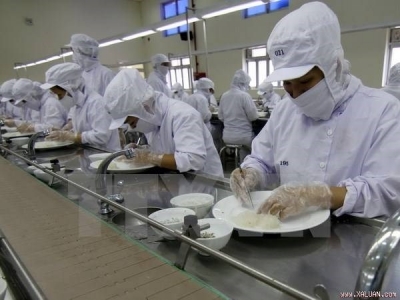Swiftlet farming looks towards sustainable development

Illustrative image (Source: VNA)
Khanh Hoa (VNA) – Experts at a workshop in Nha Trang city, central Khanh Hoa province, have suggested expanding swiftlet farms apart from exploiting the bird’s nests in nature
The event was held within the framework of the 2017 Nha Trang-Khanh Hoa Sea Festival from June 10-13, aiming to seek measures for the sustainable development of the swift-breeding sector. It drew the participation of more than 100 scientists, experts and State management officials in science, technology, agriculture, rural development, natural resources and environment.
Associate Prof. Nguyen Lan Hung Son from Hanoi National University of Education and MA Ho Thi Loan from the Vietnam Academy of Science and Technology said that by March 2017, up to 36 cities and provinces have farmed swifts for their nests with a total of more than 5,060 swiftlet houses.
Along with southern and central localities such as Tien Giang, Ho Chi Minh City, Kien Giang, Khanh Hoa, Phu Yen, Binh Dinh and Ninh Thuan, several northern cities and provinces like Hai Phong, Quang Ninh and Ninh Binh, and Central Highlands localities like Kon Tum and Gia Lai have also rolled out swiftlet farming.
With 14 speeches, participants touched upon scientific and technological issues in service of the sector, quality and origin of the bird’s nests, impacts of climate change on the formation and development of swifts in the northern provinces, and building and protecting the brand name of Khanh Hoa bird nests.
According to Associate Prof. Pham Cong Hoan from the Ministry of Science and Technology, despite their good quality, the annual output of Vietnamese bird nests still remains low, at about 10 tonnes, just equivalent to 10-14 percent compared with that of Malaysia and Thailand.
Hoan and other delegates at the workshop shared the view that Vietnam is blessed with favourable natural conditions for swiftlet farming such as a long coastline, pristine natural caves and islands.
They suggested the Ministry of Agriculture and Rural Development soon issue an official circular on the management of the sector.
Municipal and provincial authorities should put forth orientations and strategies on swiftlet farming development until 2020 with a vision towards 2030, they said.
At the same time, it is necessary for specialised agencies to conduct more scientific research in order to meet the increasing demands of the sector, including the processing method to add more values to the products.
In a recent move, the Vietnamese Swiftlet Farming Association under the Vietnam Farms and Agricultural Enterprises Association has made its debut in HCM City, aiming to link the State, scientists, entrepreneurs and farmers in the swift-breeding industry, supporting swift breeders to sell their products at reasonable prices, and building a brand for Vietnamese bird nests for both domestic and export markets.
The association will work to ensure products supplied by members of the association will have consistent quality and clear origin to protect consumers, he said.
Swift nests are high in protein, low in fat and contain various amino acids essential to the human body and other beneficial substances.
Swifts usually build their nests in deep caves on islands or along steep cliffs. In the past, people used their nests only to serve the king and noble families.
The swift-breeding industry has developed quickly in many places such as Indonesia, Malaysia, Thailand, the Philippines, Australia, and Hong Kong, with Indonesia producing about 100 tonnes of nests annually and Thailand and Malaysia about 60-70 tonnes a year.
In Vietnam, high profits have lured many investors to invest in breeding the birds indoors in recent years.
Currently, raw bird nest is priced at 20-30 million VND (880-1,322 USD) per kilo, while a kilo of refined bird nest is at 40-45 million VND, and even 100-200 million VND for some special types.
Có thể bạn quan tâm
 VN boosts aquaculture training
VN boosts aquaculture training The industry employs around nine million people directly and indirectly, but more than 60 per cent are unskilled
 Seafood exports to US face tough recovery
Seafood exports to US face tough recovery Việt Nam’s seafood exports to the United States reduced in the first five months, according to the Việt Nam Association of Seafood Exporters and Producers
 Vietnam becomes largest shrimp provider in South Korea
Vietnam becomes largest shrimp provider in South Korea A year after the Vietnam - Republic of Korea (RoK) free trade agreement became operational, Vietnam is the largest shrimp supplier of the RoK